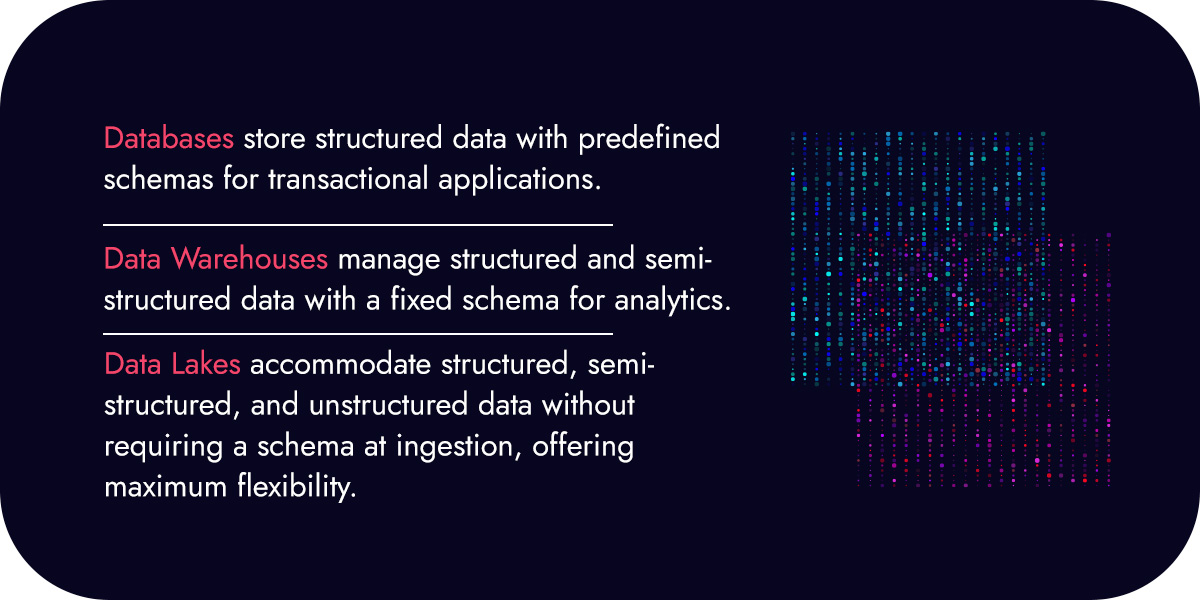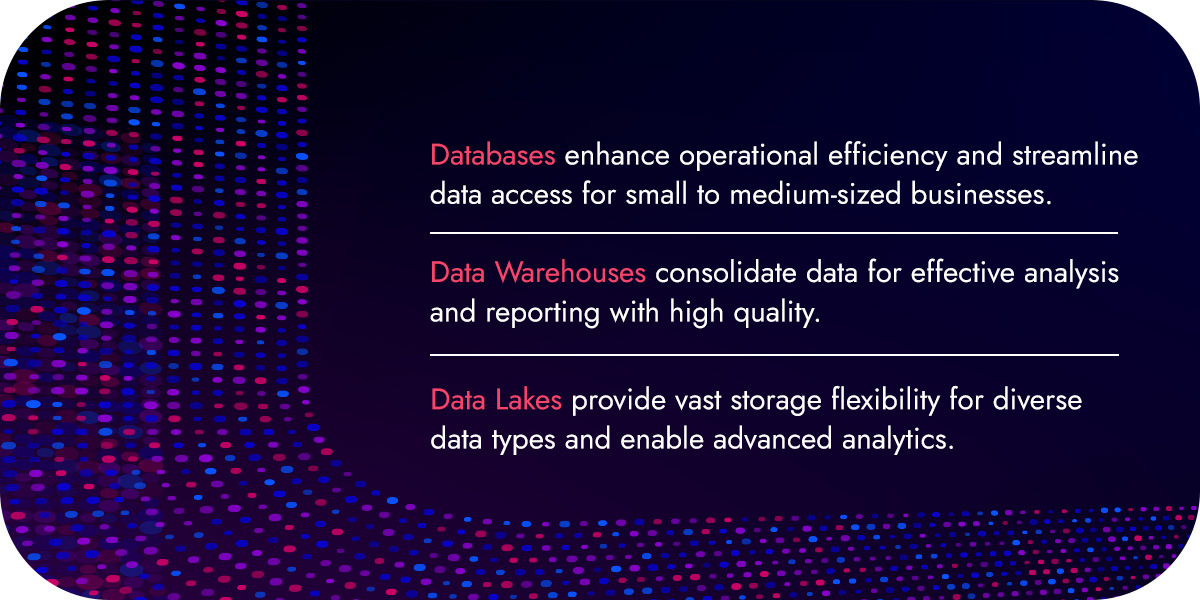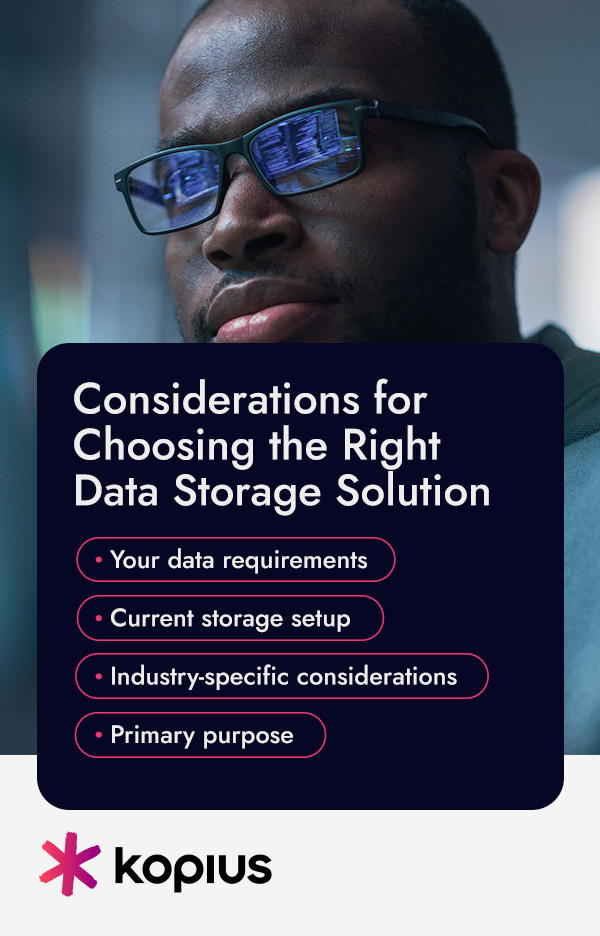
From retail to aerospace industries, managing your data effectively and securely is critical to your overall business objectives. Data storage comes in many shapes and sizes, especially with the advancements in modern digital technology. To properly store large amounts of data, you need the right location. While a database on a computer might be enough to make data accessible for a small business, a large enterprise likely requires a data warehouse or data lake.
How do you find the ideal solution? The first step is to consider the type of data you need to store and how you will use it. No data strategy is the same, so it’s important to understand how data solutions can be tailored to meet your needs.
What Is a Database?
A database is a type of electronic storage location for data. Businesses use databases to access, manage, update, and secure information. Most commonly, these records or files hold financial, product, transaction, or customer information. Databases can also contain videos, images, numbers, and words.
The term “database” can sometimes refer to “database management system” (DBMS), which enables users to modify, organize, and retrieve their data easily. However, a DBMS can also be another application or the database system itself.
There are many different types of databases. For example, you may consider a smartphone a database because it collects and organizes information, photos, and files. Businesses can use databases on an organizational-wide level to make informed business decisions that help them grow revenue and improve customer service.
Some key characteristics of a database include:
- Storing structured or semi-structured data
- Security features to prevent unauthorized use
- Search capabilities
- Backup and restore capabilities
- Efficient storage and retrieval of data
- Support for query languages
Some common uses for databases include:
- Streamlining and improving business processes
- Simplifying data management
- Fraud detection
- Keeping track of customers
- Storing personal data
- Securing personal health information
- Gaming and entertainment
- Auditing data entry
- Creating reports for financial data
- Document management
- Analyzing datasets
- Customer relationship management
- Online store inventory
What Is a Data Warehouse?
A data warehouse is a larger storage location than a database, suitable for mid- and large-size businesses. Companies that accumulate large amounts of data may require a data warehouse to keep everything structured. Data warehouses can store information and optimize it for analytics, enabling users to look for insights from one or more systems. Typically, businesses will use data warehouses to look for trends across the data to better understand consumer behavior and relationships.
These specialized systems consolidate large volumes of current and historical data from different sources to optimize other key processes like reporting and retrieval. Data warehouses also enable businesses to share content and data across teams and departments to improve efficiency and power data-driven decisions.
The four main characteristics of a data warehouse include:
- Subject-oriented: Data warehouses allow users to choose a single subject, such as sales, to exclude unwanted information from analysis and decision-making.
- Time-variant: A key component of a data warehouse is the capability to hold large volumes of data from all databases in an extensive time horizon. Users can perform analysis by looking at changes over a period of time.
- Integrated: Users can view data from various sources under one integrated platform. Data warehouses extract and transform the data from disparate sources to maintain consistency.
- Non-volatile: Data warehouses stabilize data and protect it from momentary changes. Important data cannot be altered, changed or erased.
A data warehouse can also have the following elements:
- Analysis and reporting capabilities
- Relational database for storing and managing data
- Extraction, loading, and transformation solutions for data analysis
- Client analysis tools
Common use cases for data warehouses include:
- Financial reporting and analysis
- Marketing and sales campaign insights
- Merging data from legacy systems
- Team performance and feedback evaluations
- Customer behavior analysis
- Spending data report generation
- Analyzing large stream data
What Is a Data Lake?
The next step up in data storage is a data lake. A data lake is the largest of the three repositories and acts as a centralized storage system for organizations that need to store vast amounts of raw data in their native format, including:
- Structured
- Semi-structured
- Unstructured
As the name suggests, a data lake is a large virtual “pond” where data is stored in its natural state until it’s ready to be analyzed. Data lakes are also unique because they are flexible — they can store data in many different formats and types, enabling businesses to utilize them for real-time data processing, machine learning, and big data analytics.
Data lakes solve a common organizational challenge by providing a solution to managing and deriving insights from large, diverse datasets. They allow businesses to overcome the obstacles of traditional data storage and efficiently and cost-effectively analyze data from many sources. Data scientists and engineers can also use data lakes to hold a large amount of raw data until they need it in the future.
Several key characteristics of a data lake include:
- Scalability as data volume grows
- Data traceability
- Comprehensive data management capabilities
- Compatibility with diverse computing engines
Some use cases for data lakes include:
- Ensuring data integrity and continuity
- Backup solutions
- Data exploration and research
- Centralized data repository
- Archiving operational data
- Storing vast amounts of big data
- Maintaining historical records
- Internet of Things data storage and analysis
- Real-time reporting
- Providing the data needed for machine learning
Core Differences Between Databases, Data Warehouses, and Data Lakes
The most noticeable difference between these three types of data solutions is their applications. For example, you would have much more storage for raw data in a data lake vs. a data warehouse.
Alternatively, databases are typically used for relatively small datasets, while data warehouses and data lakes are more suited to large volumes of raw data across a wide range of sources. However, other factors contribute to the distinction among these data storage options.

1. Structure and Schema
Databases work best with structured data from a single source because they have scaling limitations. They have relatively rigid, predefined schemas but can provide a bit of flexibility depending on the database type. Data warehouses can work with structured or semi-structured data from multiple sources and require a predefined or fixed schema when data flows in. Data lakes, however, can store structured, semi-structured, or unstructured data and do not require a schema definition for ingest.
2. Data Types and Formats
Databases are ideal for transactional data and applications that require frequent read-and-write operations. Data warehouses are suitable for read-heavy workloads, analytics, and reporting. Data lakes can store large amounts of raw, natural data in many formats. If comparing a data lake vs. a database, you’d have much more flexibility for different types of data in a data lake.
3. Performance and Scalability
Scalability is limited with databases, making them more suitable for small to medium-sized applications and moderate data volumes. It is challenging for databases to adapt to new types or formats of data without significant reengineering.
Data warehouses can provide a high level of scalability and optimized performance for large amounts of structured data. While they can accommodate changes in data structures and sources, it requires intentional planning. Data lakes offer the most flexibility and scalability for organizations, allowing them to store data in various formats and structures. Data lakes can also accommodate new data sources and analytical needs.
4. Cost Considerations
The cost of data storage plays an important role in deciding which solution is best for your needs. Databases offer cost-effectiveness for most small- to medium-sized applications and can scale up and down to meet changing needs.
Data warehouses provide more scalability and improved performance, but they often require significant investment in software and hardware. Data warehouses also tend to incur higher storage costs than databases. For this reason, when comparing a data lake vs. a data warehouse solution, you may get more for your investment in a data lake. Data lakes are the most cost-effective option for organizations looking to store vast amounts of raw data.
Advantages and Disadvantages of Each Solution
To further understand which data storage solution is right for your business, let’s take a look at the pros and cons of databases, data warehouses, and data lakes.

Databases
Databases can improve operational efficiency and data management processes for many small and mid-size businesses. Some key advantages of using databases include:
- Removing duplicate or redundant data
- Providing an integrated view of business operations
- Creating centralized data to help streamline employee accessibility
- Improving data-sharing capabilities
- Fostering better decision-making
- Controlling who can access, add, and delete data
Using databases can also come with several drawbacks, such as:
- Potential for more vulnerabilities
- More significant disruptions or permanent data loss if one component fails
- May require specialized skills to manage
- Can lead to increased costs for software, hardware, and large memory storage needs
Data Warehouses
Data warehousing can help your organization make strategic business decisions by drawing valuable insights. Advantages of a data warehouse include:
- High data throughput
- Effective data analysis
- Consolidated data in a single repository
- Enhanced end-user access
- Data quality consistency
- A sanitization process to remove poor-quality data from the repository
- Storage of heterogeneous data
- Additional functions such as coding, descriptions, and flagging
- High-quality query performance
- Data restructuring capabilities
- Added value to operational business applications
- Merging data to form a common data model
When working with a data warehouse, you may experience some disadvantages, including:
- Reduced flexibility
- The potential for lost data
- Data insecurity and copyright issues
- Hidden maintenance problems
- Increased number of reports
- Increased use of resources
Data Lakes
Data lakes are capable of handling large amounts of raw data, which means they can be an attractive option for organizations that require scalability and advanced analytics. Other key advantages of data lakes include:
- An expansive storage space that grows to your needs
- Ability to handle enormous volumes of data
- Easier collection and indefinite storage of all types of data
- Flexibility for big data and machine learning applications
- Capable of accommodating unstructured, semi-structured, or structured data
- Ability to adapt and accept new forms of data from various sources without formatting
- Eliminate the need for expensive on-site hardware
- Reduced maintenance costs
- Capability to integrate with powerful analytical tools
Some potential drawbacks of data lakes may include:
- Complex management processes
- Security concerns due to storing sensitive data
- Potential for disorganization
- More vulnerable to becoming data silos
Choosing the Right Data Storage Solution
Now that you know the difference between a data lake, a data warehouse, and a database, it’s time to find a solution that fits your organization’s needs. Here’s what to consider:

- Your data requirements: Not all data storage solutions can support all types of data. For example, if your data is structured or semi-structured, you may prefer a data warehouse. However, a data lake supports all types of data, including structured, semi-structured, and unstructured.
- Current storage setup: How do you store your organization’s data? Depending on where and how you store it, you may or may not have to move data to a new storage solution. For instance, a data lake may not require you to move any data if it’s already accessible, which means your organization can skip the process.
- Industry-specific considerations: You’ll need to consider the primary users of the data. For example, will a data scientist or business analyst need access to the data? Do you need it for business insights and reporting? Understanding your unique needs can help you narrow down which storage solution is best.
- Primary purpose: In addition to your industry-specific needs, consider the main function of your data storage solution. For instance, databases are often used for transactions and sales, while data warehouses are more ideal for in-depth analytics of historical trends and reporting. Because databases and data warehouses serve different purposes, some organizations choose to use both to address separate needs. Data lakes, alternatively, are suitable for large-scale analytics and big data applications. If your organization hosts large amounts of varied, unfiltered data, a data lake may be the best option.
Future Trends and Considerations
Modern data storage continues to advance and evolve. Data lake solutions, in particular, have become vital to many organizations for their unparalleled flexibility in data management. Looking to the future, organizations can expect the integration of data lakes to become more advanced with the help of digital technologies like artificial intelligence and machine learning. These emerging trends suggest promising enhancements in threat detection, data management and security, and predictive analytics.
Adopting a data lake for your business can help instill a forward-thinking approach to data management and storage. Addressing common issues like poor scalability and the constraints of a fixed schema can help your organization shift to a more convenient way to manage diverse data types.

JumpStart Your Data Journey With Kopius
Data storage and organization are unique to every business. While a database or data warehouse may suit your needs for a while, there’s no telling what your needs will be in the future.
When you partner with Kopius, you benefit from data solutions that drive strategic outcomes from one accessible location. Gone are the days of struggling to keep up with the latest transformations to power growth. Today, setting up a data lake is easier than you think.
With data lake capabilities from Kopius, you can make decisions faster, yield actionable reports and store data in all types and formats. Our turnkey solutions are designed to meet your needs, whether you require robust access control or oversight and support for your data lake.
Learn more about our JumpStart program, where we’ll create a tailored approach for your data needs. You can also contact us to schedule a consultation with our data lake developers.
Related Services: